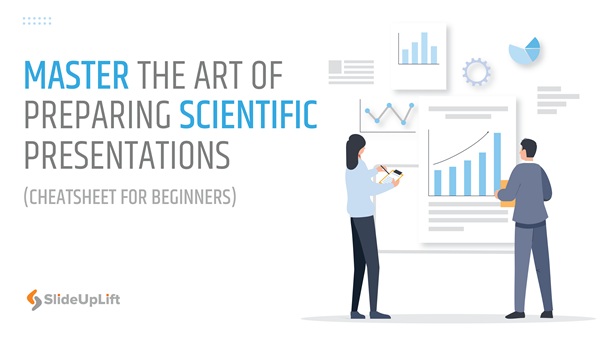Humans have been searching for answers to the world around them since the dawn of creation.

![Master the Art of Preparing Scientific Presentations [Cheatsheet For Beginners]](https://i.cdnxp.com/2022/featured/20220622085754_84000.jpg)
Humans have been searching for answers to the world around them since the dawn of creation. Our scientific method was first fairly primitive and perhaps unsophisticated. We watched and reflected. But, as research methodologies and thinking paradigms evolved, we arrived at the modern period of enlightenment and science.
So, what is the current scientific method, and how can you discuss and explain your research outcomes to others accurately?
These are the two essential questions addressed in this blog. But before that, if you want to cut down your efforts to half while creating a scientific presentation, try the exclusive range of Google Slides templates by SlideUpLift!
The scientific method is a technique of doing research that is based on theory creation, hypothesis generation, empirical testing, and theory modification if the hypothesis is rejected.
A scientific method, in essence, is a catch-all word for the procedure that every scientist use to objectively evaluate the world (and particular phenomena) around them.
The scientific method is the polar opposite of beliefs and cognitive biases, which are mainly irrational and frequently unconscious interpretations of various events that we rely on as a mental shortcut.
The scientific method in research, on the other hand, compels the thinker to analyze and test our methods of data interpretation holistically in order to achieve reliable and non-arbitrary results.
According to the Stanford Encyclopedia of Philosophy, Plato and Aristotle are thought to be the founders of the scientific method. They were among the first to use the scientific method, experimentation, and logical reasoning to try to defend and develop their thought process.
Examples of common scientific methods include:
All of the aforementioned methods are used by both scientists and companies to better understand the data and/or phenomena at hand.
Because our forefathers did not have as much information as we do, we currently live in an era of unparalleled data accessibility and connection, with over 2.5 quintillion bytes of data created every day. This has greatly expedited the generation of knowledge.
At the same time, such excessive data exposure makes us more susceptible to external influences, prejudices, and erroneous beliefs. These can undermine the objectivity of any research you do.
Scientific discoveries must be objective, verified, accurate, and consistent. The careful application of scientific methods in business world and science helps to assure appropriate data interpretation, replication of outcomes, and undeniable validity.
Whether you're presenting a poster session, a conference lecture, or a follow-up presentation on a newly published journal article, the majority of your colleagues will want to know how you arrived at the results you've provided.
In other words, they will look for flaws in your scientific method to guarantee that your outcomes are fair and reproducible so that they may use your theories in their study as well. As a result, your scientific presentation must be concise, on-point, and explicitly focused on your research methodologies.
A basic foundation for producing a convincing scientific presentation is provided here.
Here's how to easily begin a scientific presentation: Tell about your research question. On the first slide, simply summarize your thought process. Briefly describe the overarching goal of your research: Share your primary theory and indicate if you can prove or disprove it.
It may be tempting to cram a lot of information onto your first slide but don't. Keep your presentation's start brief in order to pique the audience's curiosity and prepare the stage for the follow-up story. When crafting your slides, you might find yourself needing to convert PDF to PPT to incorporate existing research materials into your presentation.
Many audience members will be interested in how you got to your conclusions, whether you are giving a science poster presentation or a conference discussion. To avoid ambiguity, provide this information at the start of your presentation.
In a presentation, here's how to structure your scientific methods:
Use bullet points instead of complete sentences. To list the methods, use diagrams and organized graphics.
When feasible, utilize images and iconography to illustrate metaphors.
Sort your methods into categories, such as measurable and non-quantifiable.
Finally, while creating visuals for your presentation, such as charts, graphs, pictures, and so on, consider yourself as a subject newbie.
Is the image conveying the most important information about the subject?
Does it aid in the breakdown of complicated ideas?
Obviously, the research findings will be your most valuable source of bragging rights. Do not, however, overburden your presentation with a lengthy description of your results and how revolutionary they may be for the community.
Instead of writing a wall of words, try this:
Overall, if the results slide becomes too crowded, it's advisable to shift the data to a new one.
Objectivity is required by the scientific method. As a result, every researcher must indicate precisely what was omitted from their study. Remember that no piece of scientific study is genuinely universal and has limits.
However, if you do not declare them explicitly, people may struggle to draw the boundary and duplicate your results. If they fail to do so, they will doubt the feasibility of your study.
Every seasoned speaker will tell you that the stuff they hear first and last is the most memorable. During the day, many people will join more than one scientific presentation.
So, if you want your audience to remember your presentation, create a take-home message for the final slide. Consider your last slide text to be an elevator pitch – a brief statement that summarizes your findings.
There is no shortage of study and scientific tools available today for testing and validating our hypotheses. However, unlike our forefathers, most scientists face greater scrutiny when presenting and explaining their discoveries to others.
That is why it is critical that your scientific presentation properly conveys the goal, direction, and thinking process underlying your study.






